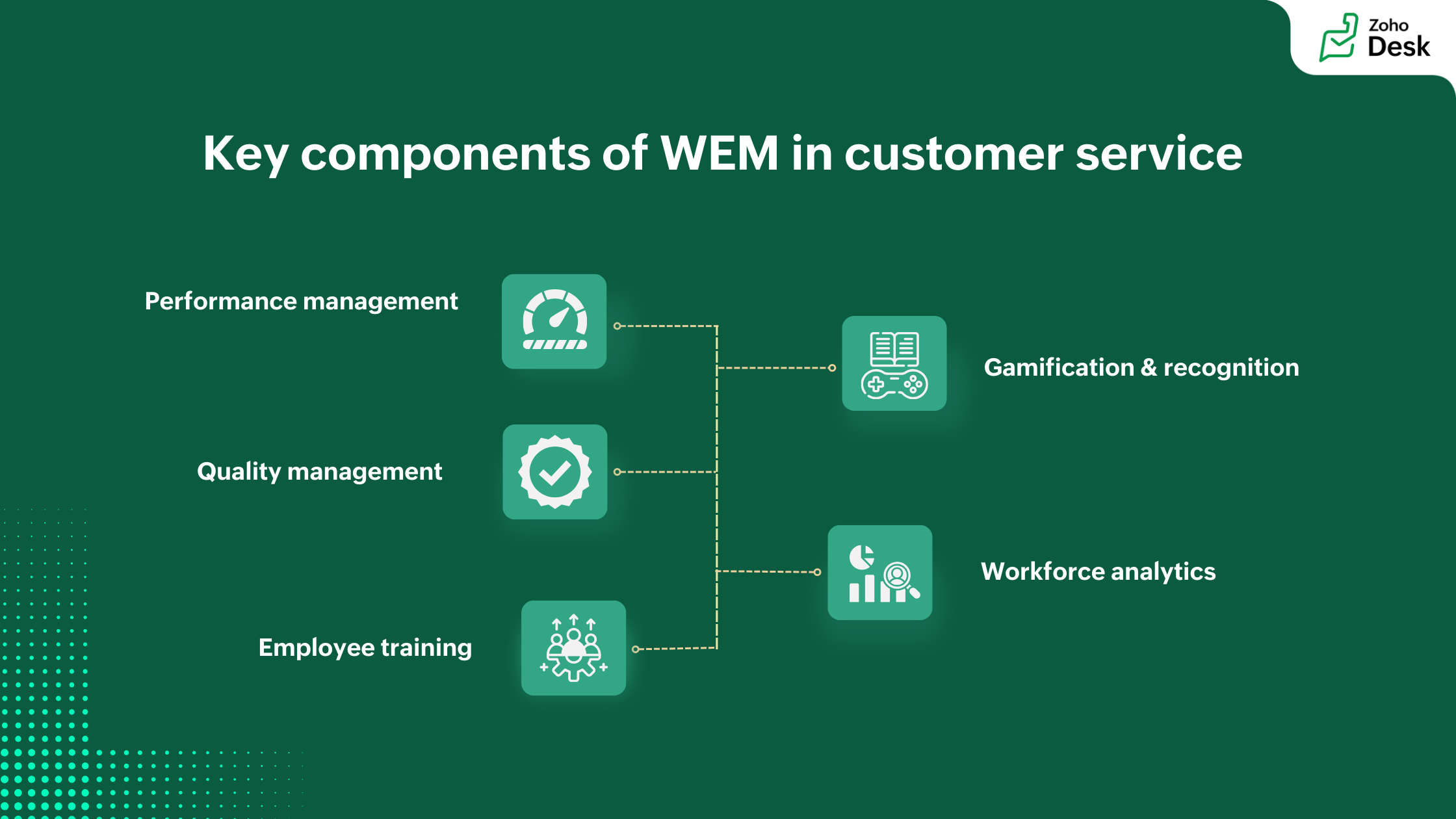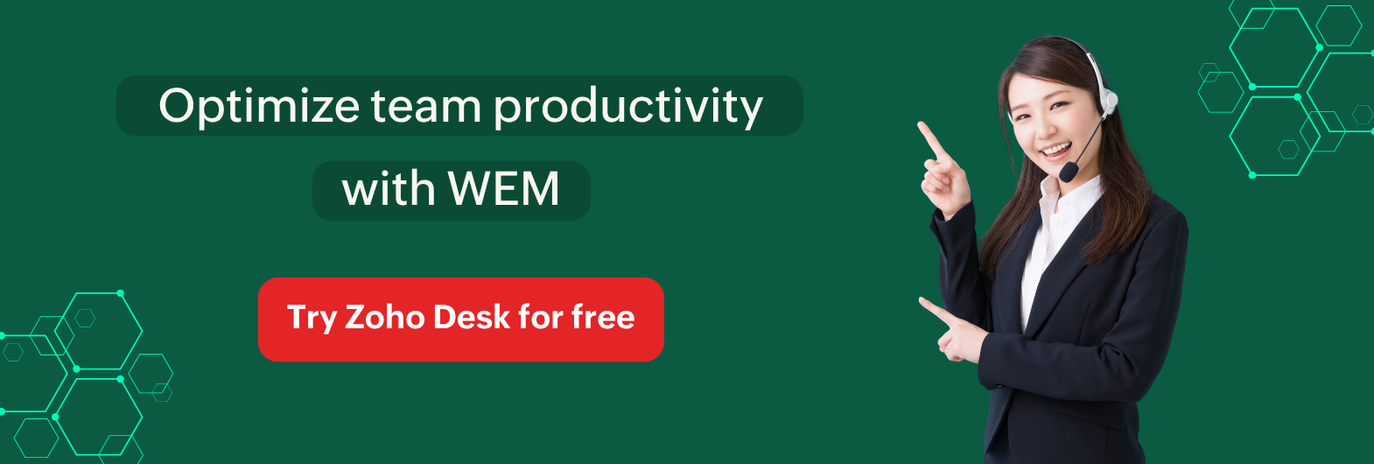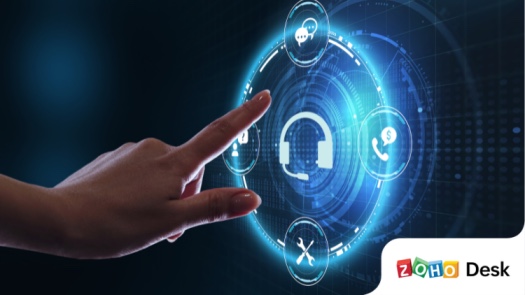- HOME
- Productivity
- What is workforce engagement management in customer service?
What is workforce engagement management in customer service?
- Published : October 24, 2025
- Last Updated : October 24, 2025
- 83 Views
- 6 Min Read

When agent experience suffers, so does customer service.
Behind every fast response, resolved ticket, or happy customer is a service agent doing the heavy lifting. But in many contact centers today, these agents are stretched thin. High attrition rates, burnout, and rising absenteeism are no longer seen as isolated issues—they’re symptoms of a deeper problem: disengaged teams working without the right support systems in place.
According to a recent Gallup report, only 30% of employees reported feeling engaged at work in 2024—the lowest in over a decade. In the world of customer service, this disengagement shows up in costly ways: agent turnover can reach up to 45% annually, and replacing a single agent can cost upwards of $15,000 in training and lost productivity.
So, what’s driving this disconnect?
One key reason is the lack of a workforce engagement management (WEM) system. Without visibility into agent workloads, real-time performance data, or flexible scheduling tools, support teams often operate in reactive mode. Agents are left feeling overworked, undervalued, and unseen—a fast track to burnout and disengagement.
As customer expectations grow, it’s clear that companies must first take care of their teams if they want to take care of their customers. Let’s explore how WEM can close this gap.
What is workforce engagement management?
Workforce engagement management is more than just a buzzword—it’s a modern, people-first approach to managing customer service teams. At its core, WEM helps support teams do their best work by focusing on three things: performance, motivation, and well-being.
When done right, WEM creates a work environment where agents feel empowered and customers feel the difference.
It brings together several key areas:
Workforce management (WFM): Forecasting demand, scheduling staff, and managing capacity to ensure the right agents are available at the right time.
Quality assurance (QA): Monitoring and evaluating customer interactions to maintain service standards.
Performance analytics: Using data to track agent productivity, identify trends, and make informed decisions.
Coaching and training: Providing continuous learning opportunities to help agents grow and improve in real time.
Employee engagement: Fostering a positive work environment through recognition, feedback, and support—all of which help reduce burnout and turnover.
In simpler terms, WEM ensures that the people behind the support desk are equipped, engaged, and empowered to meet customer needs efficiently and empathetically.
“If you take care of your employees, they will take care of your customers.”
— Richard Branson
By investing in WEM, businesses don’t just improve internal operations—they build a service culture that customers can feel at every touchpoint.
Key components of WEM in customer service
At the heart of Workforce engagement management are tools and practices that help support teams stay productive, motivated, and aligned with business goals. Here are five essential components that bring WEM to life in a customer service setting:

Performance management
WEM starts with visibility. Performance management tools help team leads monitor key metrics like resolution time, CSAT, and ticket volume—not to micromanage, but to offer timely support and celebrate wins. Agents stay focused, and managers get the insights they need to lead effectively.
Quality management
Quality assurance ensures your service stays consistent and aligned with standards. With WEM, QA isn't just about scoring interactions—it's about identifying patterns, spotting coaching opportunities, and continuously raising the bar on service quality.
Employee training and coaching
Great service starts with skilled agents. WEM integrates learning into the daily workflow through micro-learning, feedback loops, and real-time coaching. This allows agents to improve on the go without waiting for quarterly training sessions.
Workforce analytics
Data drives smarter decisions. Workforce analytics offer a complete view of agent activity, team performance, and workload trends. With this visibility, managers can fine-tune schedules, balance workloads, and improve both agent experience and customer outcomes.
Gamification and recognition
Motivation matters. Gamification elements—like badges, leader-boards, and point systems—turn daily tasks into engaging challenges. When paired with public recognition and rewards, these tools help organizations boost morale and build a culture of achievement.
Together, these components make WEM a powerful framework that supports agents at every stage, from onboarding to daily operations, and drives better outcomes for your customers.
Why workforce engagement management matters in customer service
In customer service, your team is your greatest asset. Workforce engagement management ensures that support agents are not just equipped with the right tools, but also empowered and motivated to deliver consistent, high-quality service.
Here’s why it matters:
Boosts agent satisfaction and retention
Engaged agents are more likely to stay. According to Gallup, highly engaged teams see a 51% reduction in turnover.Improves service quality and consistency
When agents are regularly coached and monitored through QA tools, service becomes more consistent—and aligned with company standards.Drives customer satisfaction and loyalty
A ZipDo study showed that 67% of consumers cite bad customer service as a key reason for switching brands—highlighting the impact of well-supported agents on customer loyalty .Enhances operational efficiency
With WEM tools like real-time analytics and smart scheduling, businesses can reduce the amount of idle time and speed up response rates without overburdening the team.
WEM isn’t just about deploying internal tools—it directly supports your customer experience strategy by aligning your team's efforts with delivering successful outcomes.
Tools that support WEM in customer service
A strong WEM strategy needs the right features—not just to monitor work, but to empower, engage, and elevate your support team. Zoho Desk includes several built-in tools designed specifically with WEM in mind. Here's how each one plays a role:
Ticket forecasting and scheduling
Predict ticket volume based on historical trends and current activity. This helps managers plan staffing levels proactively, avoid overwork and idle time, and maintain agent well-being and service consistency.
Real-time agent attendance tracking
Know who’s online, active, or idle—in real time. This visibility ensures fair workload distribution, identifies potential bottlenecks early, and allows team leads to step in when needed.
Auto ticket routing
Automatically assign tickets based on agent availability, skill set, or department. This removes the need for manual triage and helps agents focus on what they do best, which improves both efficiency and engagement.
Time tracking
Track how much time agents spend on each ticket or task. These insights help managers identify process inefficiencies, optimize workflows, and support agents who may be struggling with complex issues.
Performance dashboards
Get a 360° view of individual and team performance metrics, from resolution times to CSAT scores. With real-time data, managers can recognize top performers, spot training needs, and make informed coaching decisions.
Gamification via Gamescope
Turn everyday tasks into engaging challenges. Gamescope introduces badges, leaderboards, and rewards that encourage healthy competition, boost morale, and keep agents motivated even during high-pressure days.
Quality metrics integration
Integrate quality scores and feedback into the agent dashboard. This ensures that service standards aren’t just tracked but actively used for coaching, performance reviews, and continuous improvement.
Team feed for internal collaboration
A built-in communication space where teams can discuss tickets, share updates, or ask for help without switching tools. This fosters a collaborative culture and reduces delays caused by siloed communication.
Together, these features form a robust framework that supports every aspect of WEM from planning and execution to recognition and growth. Zoho Desk doesn’t just help you manage work; it helps you build a workplace where agents thrive and customers benefit.
What to look for in a WEM solution
Focus on these key capabilities when evaluating a WEM solution:
Feature | Why it matters |
|---|---|
Unified interface | Agents and managers should access scheduling, QA, performance, and reward tools in one place. |
Real‑time visibility and alerts | Instant insights let you spot issues early (e.g. agents falling behind, high wait times) and take action. |
Flexible automation and routing | The ability to auto‑assign tickets based on skills, load, priority, or channel reduces manual overhead. |
Integrated coaching and feedback workflows | QA scoring tied to coaching sessions helps close performance gaps faster. |
Gamification and recognition support | Built‑in game mechanics or reward tools help make routine work more engaging. |
Scalable analytics and reporting | As your team grows, your reporting should scale with custom dashboards, trend analysis, and export options. |
Conclusion: Invest in your people to elevate your service
By bringing together performance tracking, quality assurance, coaching, analytics, and motivation tools, WEM helps teams deliver consistent, high-quality customer service while also boosting agent satisfaction, reducing turnover, and improving operational efficiency.
In a time when customer expectations are rising and talent retention is more important than ever, WEM offers more than just short-term gains. It’s a long-term strategy that aligns your workforce and customer experiences to create a win-win outcome for both.
When you invest in your workforce, your service speaks for itself.



